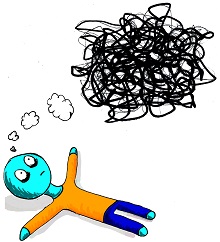Anxiety Affects Our Perceptions of Our World

Anxiety affects us in profound ways. It colors the way we think, feel, and act. Anxiety, once it takes root (Anxiety in Our Brains), it becomes a lens through which we view the world. Our interpretation of what is happening in our lives is filtered through the anxiety disorder with which we live. To be sure, it’s uncomfortable at best to experience a world colored by our own anxiety, but thankfully, we can clean that lens. After all, as Marcus Aurelius wisely observed, “Everything we see is a perspective, not the truth.”
Anxiety Colors What We See and Affects Our Perspective
Anxiety plays tricks on our mind and changes the world around us. It puts a lens over what we perceive so that nearly everything is seen through that filter. When we experience the world through an anxious mind, what we see is clouded by anxiety.
Anxiety can make us feel afraid. I typically think of fear as the color red because red warns of danger. When anxiety takes hold and creates this red lens, we see so many things as a threat. When we constantly feel threatened, anxiety grows and thrives and the red lens becomes more intense.
Anxiety can also fill us with perpetual worry. I associate worry with an electrified orange color. It’s electric and jagged because worry feels prickly and alive. When anxiety puts this spiky orange lens over our minds, we perceive people and things as worrisome. I once even perceived a box of pancake mix through this anxious orange lens and agonized in the grocery aisle for over 10 minutes wondering what impact buying it versus not buying it would have on my children. Yeah, the lens of anxiety is far-reaching and annoying.
Dread is another of anxiety’s all-encompassing side-effects. This undulating mass of anxious gray goo can make us want to avoid the world without and even the world within.
Combine anxiety’s filters, and we suddenly look at the world through a murky mess. Fear, worry, and dread plague us and it feels like we can’t escape. Of course it feels that way; that’s the perspective anxiety wants us to take.
We Can Change Our Perspective to Deal With Anxiety
Anxiety can turn the world into a horrible place. When we see the world through the anxious lenses of fear, worry, and dread, it’s easy to feel consumed by anxiety. One way to regain control and reduce the power of anxiety is to clean the lens and eventually change our perspective.
The lens is a pretty big one and anxiety has rooted it in place. Therefore, it’s not always easy to remove it. It can be done, though. Begin small. When you’re anxious, consider the possibility that what you are experiencing is merely a perspective, not the truth.
When your mind is used to questioning the reality of the things that are making you anxious, you can begin to test that reality. Perhaps you are afraid of going somewhere for fear of being judged harshly. What evidence do you have that that will happen? Will everyone judge you? If a few people do, what are the consequences? What positives can you focus on? Perhaps you’ll wipe off just enough of the murky mess off of your lens of anxiety to see clearly enough to make it to where you need to go.
Anxiety makes us see the world from its perspective. Start clearing that filter and begin to create your own perspective of yourself and your world.
Connect with Tanya on Facebook, Twitter, Google +, LinkedIn, her books, and her website.
APA Reference
Peterson, T.
(2014, December 4). Anxiety Affects Our Perceptions of Our World, HealthyPlace. Retrieved
on 2025, December 7 from https://www.healthyplace.com/blogs/anxiety-schmanxiety/2014/12/anxiety-affects-our-perspective
Author: Tanya J. Peterson, MS, NCC, DAIS
Thank you for the vivid illustration of anxiety. I too struggle with worry and anxiety. I have to remind myself that an impending dread is not outside my door. When anxiety (orange lense) takes over, I have to take a break and recharge. It is definitely an uphill battle.
Annette, it truly feels uphill, I’ve dealt with it since I was young, now in my 50’s it’s nice to at least have years of experience to naturally alter my perception and make it easier to question my many errant thought processes. I try to use this challenge as more of an opportunity to strengthen myself and become more of what and who I’d like to be. Good to know I’m not alone in the struggle. Thanks for sharing, I wish you the best! :)
I see people differently and it’s because i’m afraid and worried about them and our relationships. It’s hard on me. but i’m grateful for the people in my life. Thank you for sharing
Hi Liz,
Worrying about relationships and loved ones can be exhausting and stressful. The ability to experience this and feel grateful is a skill and an attitude that will help you keep things manageable.
Thank you. This illustration helped me understand myself a little more,not to mention it will help me tell my story to those that care :)
Hi JD,
Thank you for your comment. I'm glad to know it was helpful -- both for anxiety and for telling your story! Being able to tell our stories and have people listen is very empowering.
Enjoyed the article and it does literally color my thinking. For me anxiety changes the quality and color light, think glaring spot light vs. warm light from a candle or fireplace.
Hi Debra,
I love your imagery of the glaring spotlight and the warm firelight! What perfect descriptions. I'm glad you shared this for all readers to see. :)
What a great illustration of how anxiety can affect our perceptions and interpretation of things.
www.chicagoclinicaltherapist.com
Hello Deerfield Therapist,
Thank you! I appreciate your reading this and commenting. :)
Anxiety does color the way i think for sure. I try to be positive but it can be an uphill battle. Im going to try this for sure.
Hello RT!
Thank you for your comments. I think a huge number of people (myself included) can relate to your observation that staying positive and beating anxiety can be an uphill battle. When we find little tricks and techniques and new perspectives, they can help push us up that hill slowly but surely. Good luck in your climb!
